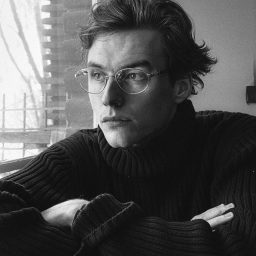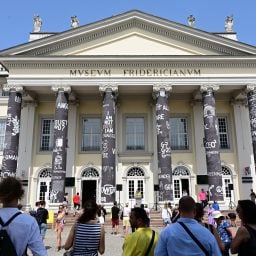“This Documenta will be like no other Documenta,” says Paul B. Preciado some four hours into a 14 hour documentary about the 2017 edition of the prestigious German quinquennial art show. He clarifies: “It will be the last one… A Documenta for the end of times.” Among its facets, Dimitris Athiridis’s 2024 film Exergue—which means other side of the coin, apt for an exhibition most famous for going millions of euros over budget—is an uncanny and oddly reassuring reminder of how the world used to be ending not so many years ago, albeit in a slightly different way from how it is ending now.
Premiering at the annual Berlinale last month (the documentary was viewable over the course of two days, with six and half hour segments split up with a 60-minute intermission), Exergue is the product of Athiridis tailing around artistic director Adam Szymczyk and his large curatorial team, among them Preciado who served as curator of the public program, capturing 800 hours of footage across four years leading up to their controversial exhibition. “Learning from Athens,” as Szymczyk’s Documenta was called, took place between its usual home of Kassel, a famously uncharming town amidst the rolling hills of Germany’s fairy tale land, and the Greek capital, then the nexus of financial collapse and the ensuing neoliberal austerity measures imposed via the E.U. and Germany’s then-chancellor Angela Merkel. The shores of the bankrupt Aegean island state were also the frontlines of the refugee crisis that included Syrians in the thousands seeking shelter.
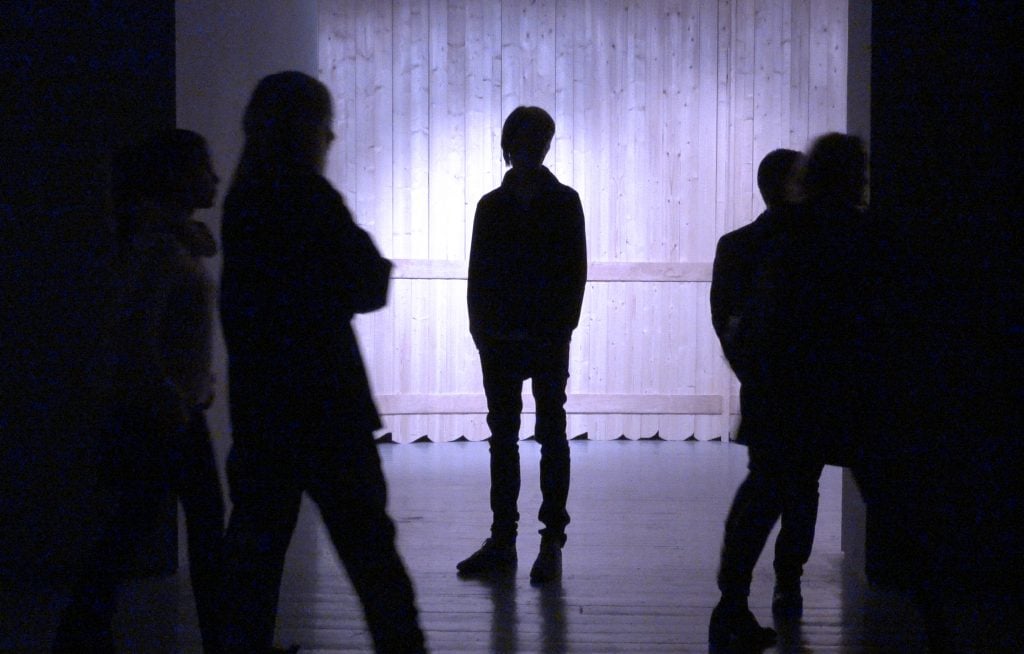
Adam Szymczyk with Edvine Larssen’s Verging (2016) © Faliro House Productions
Exergue tells the story of an art world in a chronic state of attendance at the end of times, of its wrinkled and wonderful minds that etch out a living out by grappling with this paradox. At different points in the film, the ensemble of curators is periodically distracted from their work as gunshots sound from a rooftop during a research trip to pre-blast Beirut; members of Greece’s alt-right party Golden Dawn set fire to an African street vendor’s property right outside Documenta’s HQ and the team looks on in disbelief as they smoke their cigarettes in the lights of the blaze. When news of the Paris shooting in November of 2015 ticks in, Preciado reflects that “we have to be more radical, like never before.” Speaking to the writer Kaelen Wilson-Goldie in Beirut about the traveling circus of the art world, Szymczyk bluntly states that “the party’s over.”
Of course, there have been more shootings and devastation, in Paris and elsewhere—one loses track. Meanwhile, the party Szymczyk refers to continues to end and return; it is the same one that was over when COVID hit in 2020, before going into turbo-mode with more coke-fuelled pop-ups in Seoul, Hong Kong, and Los Angeles. It is a party so grotesque in its nature that it must necessarily always be ending in order for us to bear the fact that it happened in the first place, and that we all went and that we are still there.
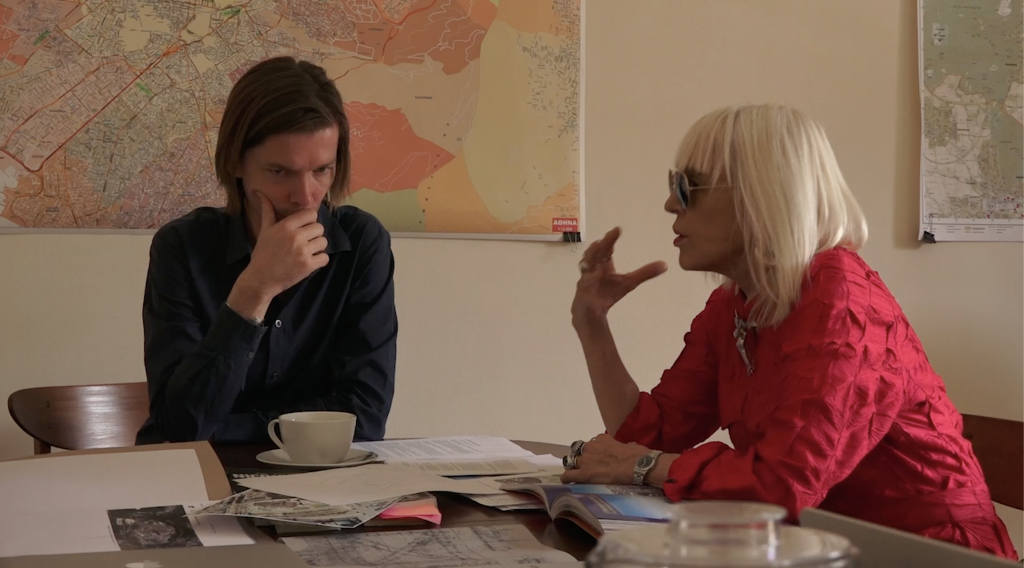
Adam Szymczyk and Marta Minujín © Faliro House Productions
The premiere of Exergue meets us in a moment when, in the aftermath of Documenta’s subsequent fifteenth edition, the time-worn organization really does seem to be in death throes. The exhibition in 2022—curated by the Indonesian collective ruangrupa deploying a mode of decentralized authorship that was attractive mostly on paper—included an anti-semitic caricature that shot parts of the German public into a state of collective psychosis we’ve come to know well in the years since. Last fall, the organization’s finding committee that was set up to elect the curator for Documenta 16, fell apart after member Ranjit Hoskoté resigned following accusations of anti-semitism due to his signature on a petition condemning a well-documented alliance between Zionism and extremist Hindu nationalism (Hindutva) back in 2018.
In an open letter to the CEO of Documenta, Andreas Hoffmann, Hoskotés wrote: “It is clear to me that in this poisoned atmosphere there is no room for a differentiated discussion of the issues at hand… My conscience does not allow me to accept this blanket definition [of anti-semitism] and this restriction of human empathy … A system that insists on such a definition and such restrictions—and that chooses to ignore both criticism and compassion—is a system that has lost its moral compass. I say this with the greatest sadness.”
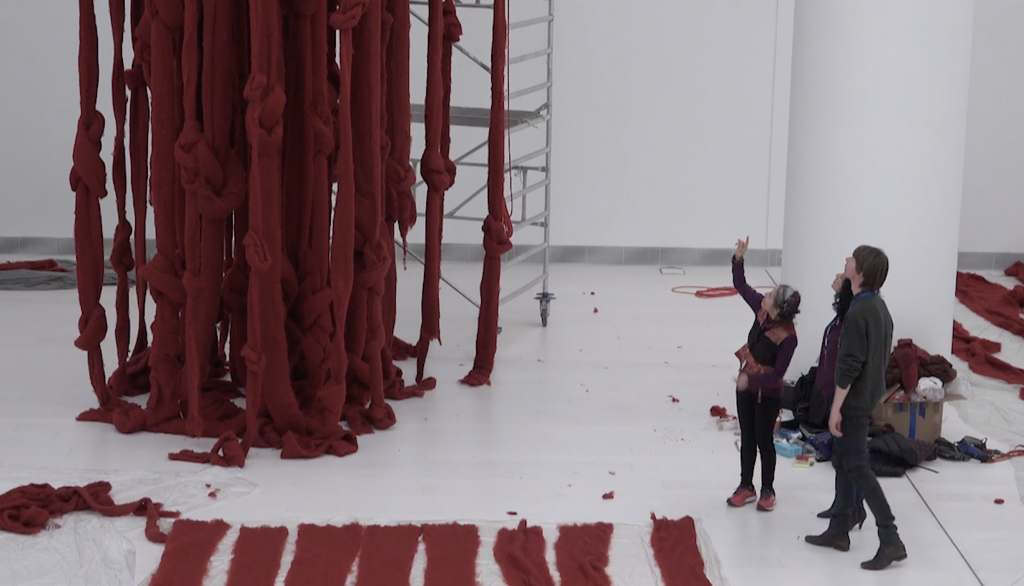
Adam Szymczyk, Katerina Tselou, and Cecilia Vicuña with Quipu Womb (The Story of the Red Thread Athens (2017) © Faliro House Productions
That same month in 2023, as Artforum saw the dismissal of its editor-in-chief in the wake of an open letter, which was followed by a walkout of key members of its editorial staff, it seemed modernist institutions were falling like flies. And so it would not be #MeToo, nor austerity measures, nor the pandemic, nor the near-bankruptcy caused by Documenta’s sojourn in Athens, but a strange and wilful mobilisation of inherited guilt under the sign of real political violence that would end the party. Exergue emerges as we wonder whether this time, it may actually be over for good.
More than anything, across its 14-hour run Exergue becomes a character study of Szymczyk, his generation, and his milieu. The Polish curator, born in 1970 and formerly the rock-star director of Kunsthalle Basel, is a perfect specimen of the aughts: with skinny jeans, emo haircut, lanky boyish appearance, and Margiela stitches on the back of his black blazer. He is Tilda Swinton and Tom Hiddleston in Only Lovers Left Alive. He rarely raises his voice but instead flips his hair and mysteriously wanders off camera or takes a picture with his phone at the edge of the screen. He is sensitive, but not neurotic—he is not a millennial. He plays Nick Cave on piano, wears a tote bag, smokes endlessly, unbuttons a bottle of Amstel and believes that art can have real political impact. I personally have assigned art a somewhat more modest role vis-a-vis the world’s various fires than Szymczyk. Yet I am happy for Szymczyk, the fantast, the incorrigible dreamer. Perhaps his was the last Documenta. What we saw in 2022 was a denouement, a final blowout on a ruined campsite.
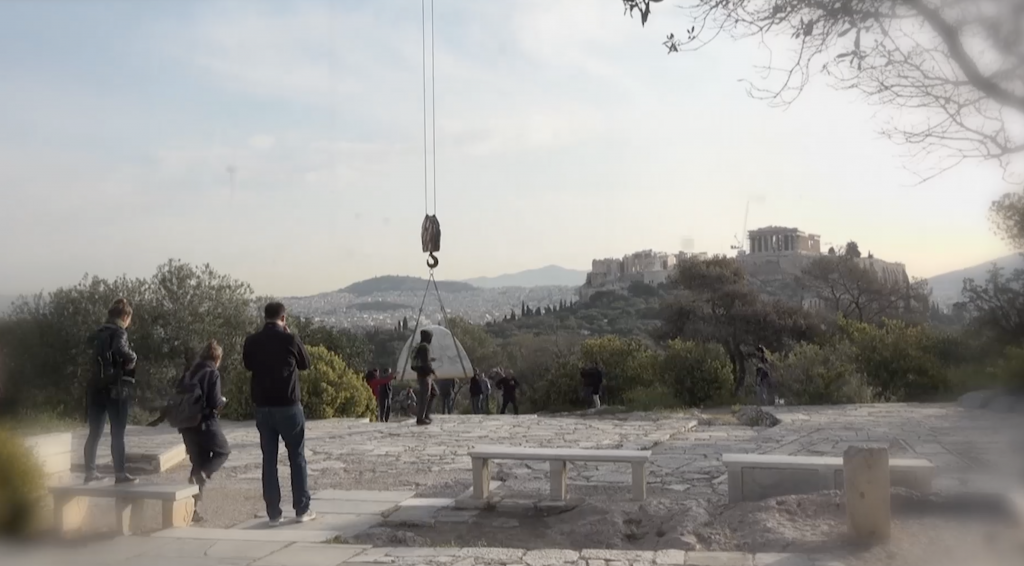
Rebecca Belmore, Biinjiya_iing Onji (From inside), 2017 © Faliro House Productions
We watch his cohort artist Douglas Gordon asking for the nearest hospital: “I will have a breakdown in about 15 minutes,” he says. We see lit minds and idiosyncratic temperaments that are powerless in the face of practicalities, who are wizards at projection. I did not expect to sit through as many hours of Athiridis’s documentary as I did, but Szymczyk’s particular Gen X charisma kept me, if not exactly hooked, then lulled into a type of charmed complacency, exerting the kind of patience usually reserved for the young. We see Wilson-Goldie get turned down for a photo op of Szymczyk (for Artforum’s series Scene & Herd). Szymczyk declines, saying he doesn’t like how that “gossip column” tends to throw everyone—artists, dealers, collectors, critics—into “the same pot.” (He later takes the picture.) Exergue is a portrait of this pot-ness that Szymczyk seems to willfully or strategically deny.
Documenta 14’s main problem was its size. This much is clear from watching Athiridis’s film and also from having visited the exhibition back in 2017—both from a financial perspective and an art critical one. There is simply no reason to produce a show of such a magnitude, especially one that purports to be critical of capitalism, spectacle, growth, and of the imperialist ambition to grasp the whole world through a single project. In Exergue we watch this car crash happen in slow-motion.
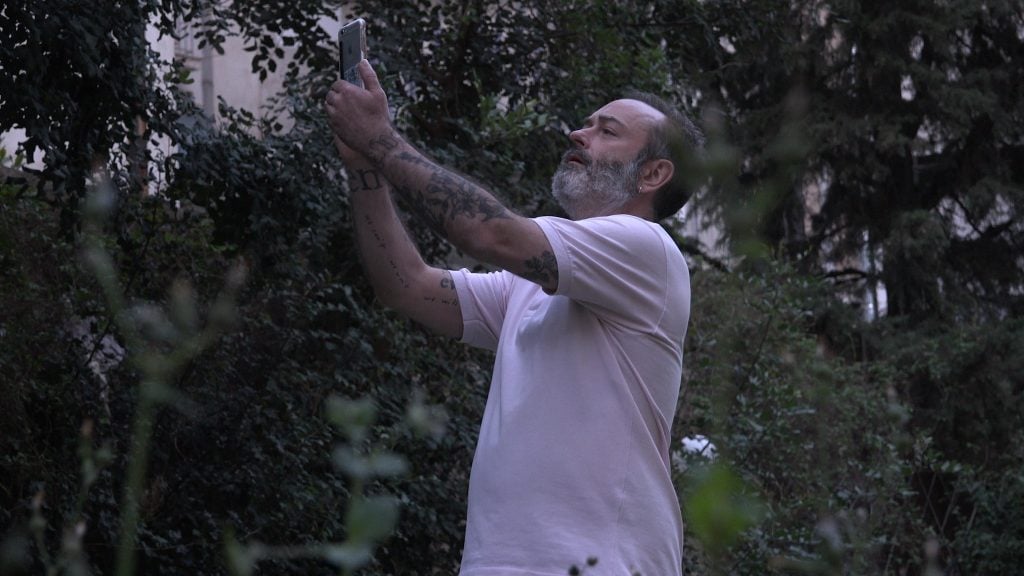
Douglas Gordon © Faliro House Productions copy
Dieter Roelstaete, also on the Documenta 14 curatorial team, is another of the film’s delightful Gen X characters. After they’ve gone through “101 artists proposing 101 projects,” he asks whether, given the mounting financial woes, this is not when they should decide which ones to go for and which not: “Or am I deluded? Am I hallucinating?” Roelstaete even brings a scythe to prove his point. There is some laughter. “You mean cuts and austerity measures,” says another curator Monika Szewczyk—jokingly but also not.
At another point in the film, Szymczyk offers his counter-argument: that they need more artists to balance the exhibition’s identity matrix, with Szewczyk chiming in that they should distribute as much money as possible to as many artists as possible as a matter of political principle.
So, if one wonders why this room full of curators is so hesitant to curate—that is, to choose one thing and not another which is surely the crux of the profession—the answer perhaps lies in the ethos of this team, a sense that “curating” is paramount to a kind of economical redistribution. After formalism (which, in 1972, critic Robert Hughes called “a game not worth playing anymore”) a new game developed out of the discourses of globalization and postmodernism: attitude morphed into identity, pluralism into intersectionality. By the time Szymczyk came around, the game had become one of casting a net so wide, and stretching it at every corner to include every possible subject position, that the centre—as Yeats’s famous line goes—could not possibly hold.
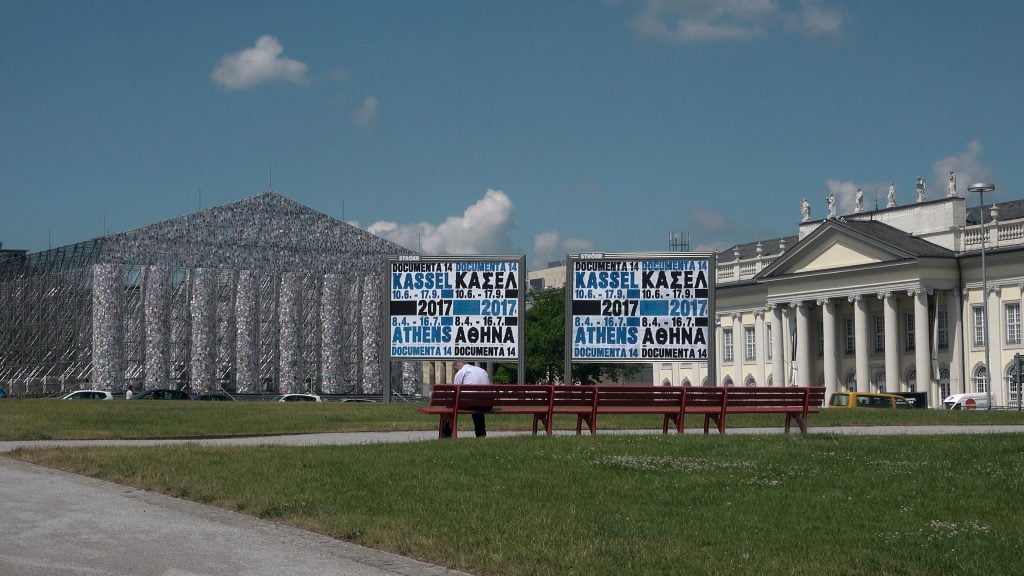
The Parthenon of Books (2017) by Marta Minujín, Kassel, Germany © Faliro House Productions Kopie
This method of curation has since become something a recipe for every major exhibition. The upcoming Venice Biennale, called ”Foreigners Everywhere,” includes more than 300 artists most of whom are from the Global South. Szymczyk calls it “global shopping” and attributes it to Carolyn Christov-Bakargiev’s 2012 Documenta, admitting that “it was good,” and noting his own edition would “do the same, but more.” In another emblematic scene, we see Preciado lay out the thematic ground that the exhibition proposes to cover:
“ruins, monumentality, multiple temporalities, multiple modernities, institutional ruins, new institutionality… politics versus state craft, disability studies, anti-psychiatry, sexual politics, post-porn politics, trans-feminism, energy politics… death, radical mourning, necropolitics, technologies of consciousness, epistemologies of the oppressed… shamanism, multi-naturalism, architecture as protocol for the invention of freedom… pan-africanism, black traditions, anti-colonial and decolonial knowledges, first nation peoples, indigenism… radical pedagogy.”
At the end, Szymczyk comments that the list is “kind of maybe lacking… realism?” A couple of smiles break out around the table, and even in the cinema one could sense a palpable moment of relief from the audience as Roelstraete concedes that this all does sound “slightly unrealistic.” However it soon becomes clear that Szymczyk is actually talking about the realism of Gustave Courbet—socialist realism. Of course! Nevermind reality.
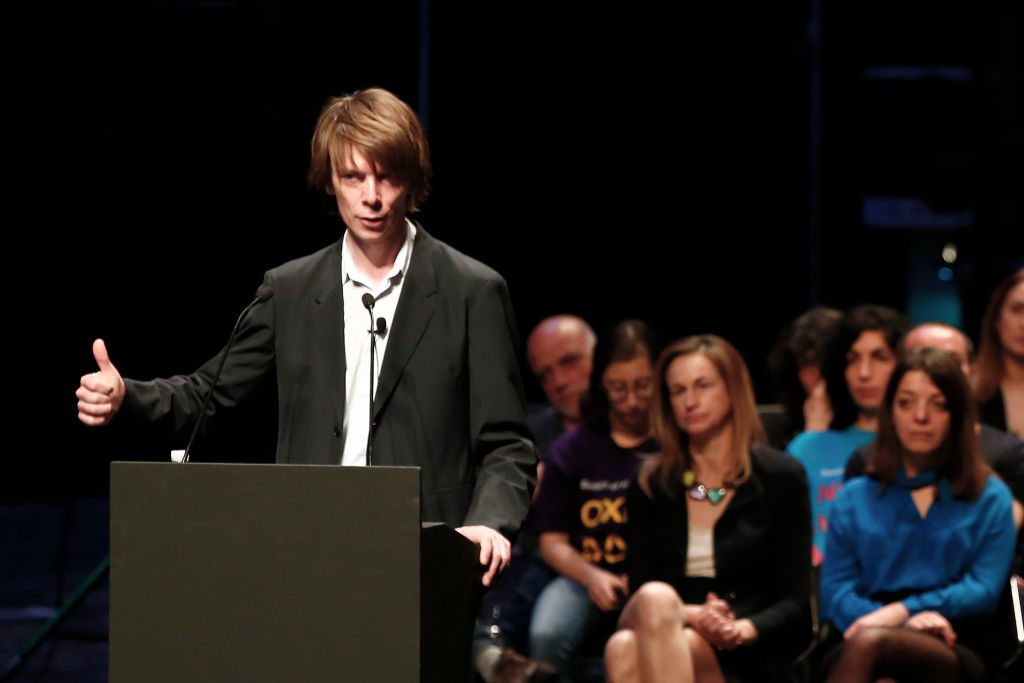
Artistic director of documenta 14 Adam Szymczyk speaks at a press conference of documenta 14 at the Athens Concert Hall on April 6, 2017 in Athens, Greece. Photo by Milos Bicanski/Getty Images
When the budgetary issue becomes too great to ignore, Roelstraete organizes a summit at the unimposing site of the so-called Währungskonklave (currency conclave) where officials had met in 1948 to reconstitute the German currency. In this evocative setting, the revelation of the concept of “money” as an arbitrary cultural construct seems to offer at least a provisional solution to their problems—a wonderful move, priceless in its welding of intellectual ambition and practical absurdity. Moments such as these make “Learning from Athens” look like an accelerationist plot to dismantle modernism and capitalism—or, at the very least, the Documenta gGmbH, modernist relic of an institution that it is—and Preciado’s quip about “the last Documenta” echoes less like a grim prediction than a statement of intent. In this, Documenta 14 was almost successful—if only the art hadn’t been as good as it was.
For, as Daniel Birnbaum remarked in Artforum at the time, there was a “show-within-a-show;” behind the savior complex, the political allegory, the auto-ethnography, there was a trove of excellent works, intelligent and erotic, in turn. Seven years on, I remember whole rooms of the Neue Galerie in Kassel and the EMST in Athens: Alina Szapownikow together with Lorenza Böttner was electric. Stanley Whitney’s color fields, the Sami Flags, Ernest Mancoba’s watercolors communicated something so clear about abstraction, musicality, and power; Vivian Suter in the Acropolis Park; Jonas Mekas upstairs in the train station. Lines burst out of canonical modernism to loop in Amrita Sher-Gil and trace back to Johann Winckelmann.
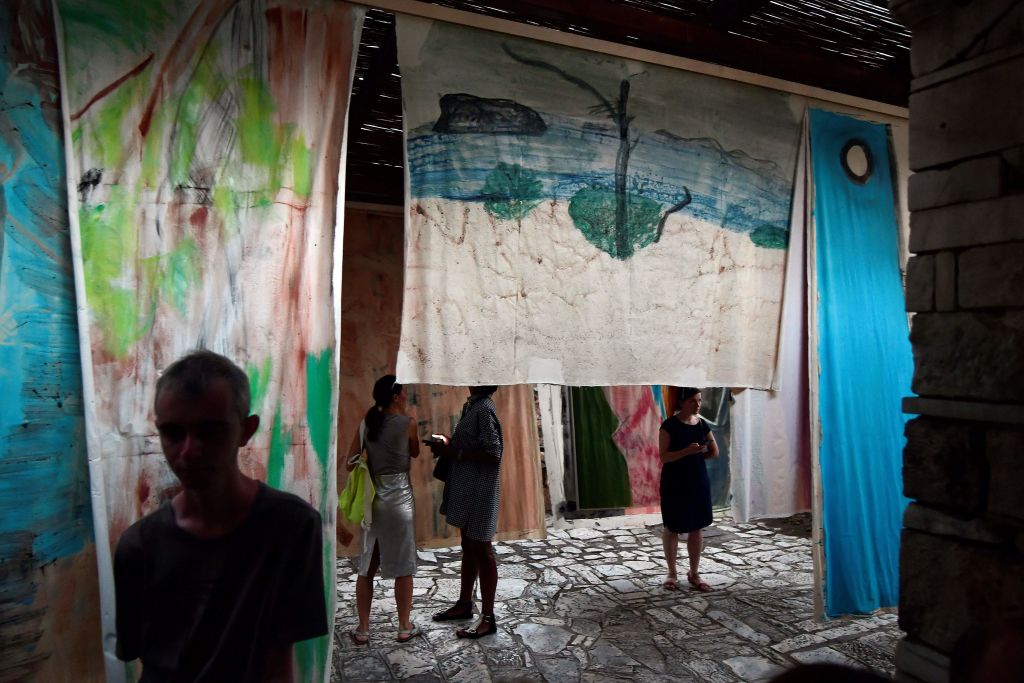
People visit an installation by Argentinian artist Vivian Suter called “Nisyros” at the frames of Documenta 14 art exhibition, at Filopappou Hill in Athens in July 14, 2017. Photo: Louisa Gouliamaki/AFP via Getty Images)
No one would have anticipated it then, but so many of the artists featured have cropped up across the European institutional landscape again and again in the years since, just as so many of the issues on Preciado’s laundry list have become lightning rods. It could have been circumstantial—I was younger then—but I don’t think I’ve felt quite like that about an exhibition before or since. In Kassel in 2017, I left my group behind, skipped lunch, just kept going, wanting to know where the argument would branch off to next. It was an argument that worked intellectually—and this was the great feat—without being primarily cerebral. You took the leap with them, as Annette Kuhlenkampf, Documenta’s then-CEO, also did (a 64 million euro leap), and you take it again, with Athiridis—for 14 hours.
No amount of dextrose could have saved Documenta 15. There was no exhibition-inside-the-exhibition because there was barely an exhibition behind the curatorial foil. The anti-semitism scandal of that year could not have happened in the same way in 2017 because no one would have believed any picture in Szymzcyk’s show to be so simple or unselfconscious. By staying in line with the Contemporary Art trademark, Documenta 14 reaped the benefits of the complex object ontology developed within that field by which Taring Padi’s mural may have at least been partly buffered by critical reflexion.
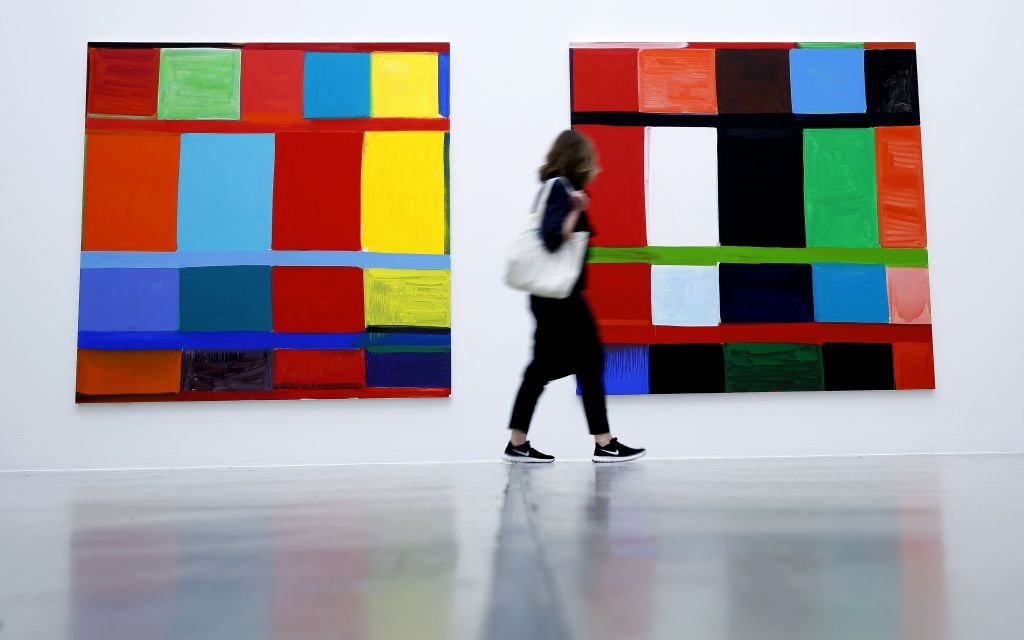
Paintings (2017) by US-artist Stanley Whitney are pictured the Documenta 14 art exhibition in Kassel on June 7, 2017. Photo: Ronny Hartmann/AFP via Getty Images
When, during Documenta 14, theorist “Bifo” Berardi had his performance canceled for comparing the refugee crisis with the Holocaust, a new performance was staged to address the issue intellectually. “Yes, I am ashamed,” responded Berardi. “Ashamed that I cannot stop fascism.” Roetstaele, when presenting the planned inclusion of the then-recently recovered estate of Nazi art dealer Hildebrand Gurlitt, explains the German government’s resistance by saying they have a strong interest in using the recovered paintings as an opportunity “to publicly expatiate their guilt.”
Five years later, Taring Padi’s caricature presented another such opportunity, but this time ruangrupa—whose biggest success was managing to fall wholly outside that art world pot (we know that barely anyone from the concurrent Art Basel had reason to attend the opening)—had few tools to defend themselves. What I saw in their great after-party was art demoted to the status of a more or less arbitrary outcome of community activity. But exhibitions have publics, not communities. To make art for a community is to concede to making art for your friends. To me, that spells art for the end of times.
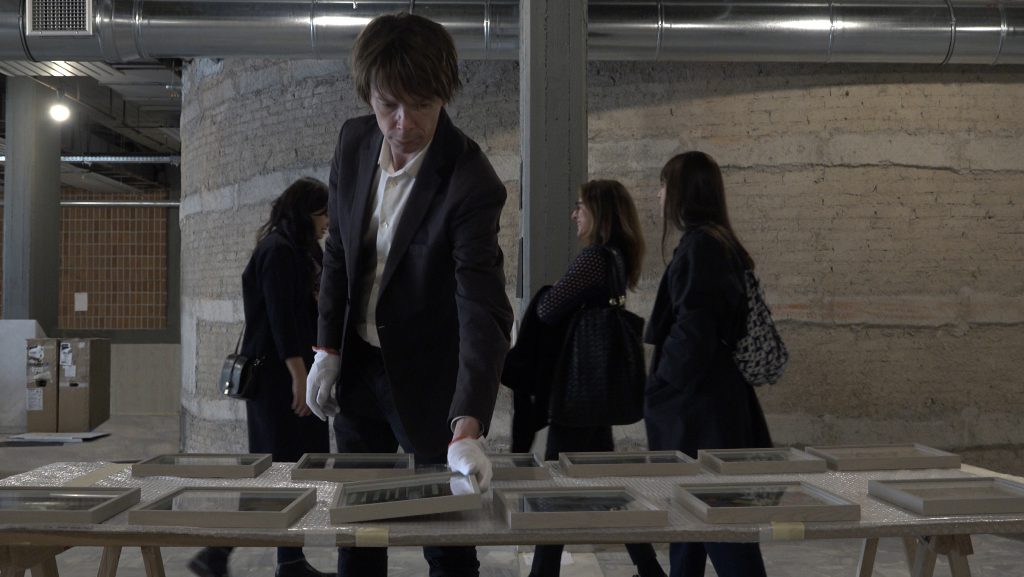
Adam Szymczyk © Faliro House Productions
Documenta 14, too, included this pretension: to effect real social impact in Athens, build relationships, not be a UFO. In this respect, Szymscyk wanted to have his cake and eat it too—cultural prestige and grassroots credibility; theory and practice. The cake, more concretely, was the Greek National Museum of Contemporary Art, EMST, which he got in exchange for giving the Kassel Fridericianum over to a display of their collection. Theoretically, as his curators excitedly exclaim when the idea is first presented, “it puts everything into place” and “addresses the issues of repatriation [and] archaeology.” But in practice, as Exergue shows, the invitation to the Fridericianum was first and foremost the solution to a problem of square meters in Athens, and it read that way to viewers, too—as if you did not even need to actually see it. The ESMT director, Katerina Koskina, a small, busy lady, tough as jerky, smelled foul play from the onset, and resisted in her various creative ways until the end. In Athiridis’s film, she takes on the role of villain. Or anti-hero?
But what could Documenta possibly have fixed for the Athenians, for the Greeks, for refugees, or for anyone anywhere? Was its landing in Athens a form of crisis tourism? Yes. But it was also something else: an art exhibition. An intellectual, political, and artistic proposal, rare in scope and ambition. The other side of the coin shows a group of sharp, creative minds playing a game that couldn’t be won.












